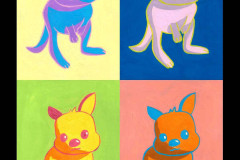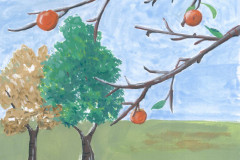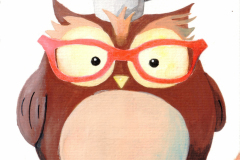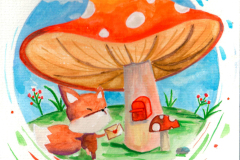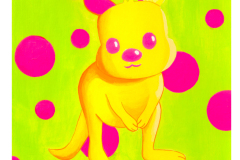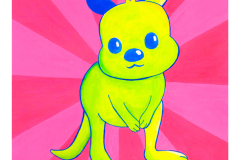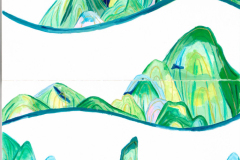Introduction
Capturing the freedom of birds in the sky with mixed media is a creative way to combine nature and art. Birds inspire many artists because their flight represents freedom and beauty. Using mixed media, artists can show the movement and colors of birds in an interesting and unique way. This article will explore how you can use different materials to represent birds flying in the sky.
We will also learn about birds, how they fly, and why they are special. Through art and science, you can see the connection between the natural world and how it can be expressed on paper or canvas. This information can help you understand both birds and mixed media art better.
What Are Birds and Why Are They Special
Birds are living creatures that share a set of traits setting them apart from other animals. At their core, they’re warm-blooded vertebrates with backbones, just like mammals and reptiles. But what really defines them is their anatomy and behavior.
One simple way to think about birds is that they combine features from different animal groups in a unique way. They have beaks without teeth, which is unusual—no chewing, just pecking and tearing. Their feet often have claws designed for perching, climbing, or walking. More distinctively, birds are covered with feathers, which no other animal has.
What makes them special isn’t merely this collection of traits, but how these parts work together. They’re the only group with the ability to truly take to the skies, though not all can fly. Their skeletal structure is light but strong, optimized in a way that supports flight yet still allows movement on land. Thinking about it, birds feel like nature’s experiment in balancing lightness and strength.
Birds and Their Unique Qualities
Feathers are probably the first thing that jumps to mind when you imagine birds. These aren’t just for show—they insulate, waterproof, and help with flight. Feathers come in many types, from the fluffy down that keeps chicks warm to the sleek flight feathers that cut through air.
Wings, shaped differently depending on the bird’s lifestyle, are central to their identity. Some have broad wings suited for soaring, others narrow and fast for quick maneuvers. You might wonder why wings—and feathers—are so crucial. They evolved together to allow flight but also play roles in courtship and camouflage.
One feature often overlooked is how birds reproduce. They lay hard-shelled eggs, unlike most reptiles, ensuring their future young stay protected. Eggs are usually laid in nests, which vary from simple scrapes on the ground to complex woven structures. It’s fascinating how such small beginnings can lead to creatures capable of flight.
The Importance of Birds in Nature
Birds serve multiple roles in ecosystems, some you might not immediately consider. For one, they help control insect populations. When I watch a flock of swallows swooping after bugs, it’s clear they keep some balance in nature.
They also act as pollinators and seed dispersers. Plants depend on birds moving from flower to flower, or carrying seeds far away from the parent plant. Without birds doing that, many ecosystems would be very different.
Plus, birds are indicators of environmental health. Declines in bird populations often hint at bigger issues—like pollution or habitat loss. Sometimes I think we overlook this, but watching birds might be one of the easiest ways to sense changes in nature’s balance.
How Birds Fly High in the Sky
Flight depends on three main forces that work together—lift, thrust, and drag. Lift is what pushes a bird upward, created by the shape of its wings slicing through the air. Thrust moves the bird forward, usually generated by flapping wings. Drag, on the other hand, slows it down, caused by air resistance.
Birds move their wings in surprisingly complex ways to control these forces. When they flap, they push air down and back, which creates both lift and thrust. The upstroke often folds the wings slightly to reduce drag, which might seem like a clever shortcut rather than brute force. Watching a bird, you might not realize how much subtle muscle work goes into every beat of the wing.
Different birds rely on varying flight styles:
- Gliding: Large birds, like hawks or albatrosses, often spread their wings wide and use rising air currents to stay aloft with minimal effort.
- Flapping: Smaller birds, like sparrows or robins, rely heavily on rapid wing beats to move and stay up.
- Bounding flight: This method, seen in finches or woodpeckers, combines bursts of flapping with short pauses where wings fold, saving energy during long flights.
Sometimes you see birds seeming to “hover” or stay in place. It’s almost like they’re defying physics. But it’s really tiny adjustments to wing angle and rapid wingbeats fighting the constant pull of gravity and drag.
Have you ever wondered if a bird feels the wind more than we do? Their wings adapt instantly—every movement counts. There’s a kind of fluid conversation with the air going on, which is part of what makes observing flight endlessly fascinating.
Birds in the Sky
The sight of birds soaring through the sky is a simple yet profound experience. Watching them glide, flap, and dip gives a sense of freedom that’s hard to capture but easy to feel. Birds don’t just move through the air; they interact with it, responding to wind currents and shifting weather patterns in ways that can seem almost instinctual—sometimes even unpredictable.
What fascinates me is how varied their movements are. Some dart quickly with sharp wing beats, while others drift gently, almost motionless against the blue. These differences are tied not just to species but also to purpose—hunting, migrating, or socializing. Their flight paths sketch invisible lines in the open sky, patterns that might inspire any artist who observes closely.
It’s curious how the ever-changing light affects how we see birds in flight. A silhouette might suddenly gain depth when the sun strikes just right, creating shadows on feathers or highlighting delicate wing structures. These fleeting moments challenge artists to capture that elusive sense of motion and space—a task easier said than done.
Birds also symbolize more than movement. For many, they represent hope, escape, or perspective. But can art fully express what it feels like to watch their flight? Maybe this is why many creatives turn to mixed media—to layer elements, textures, and techniques, not unlike how birds layer feathers and adjust their wings.
When you look up at the sky next time, notice the subtle shifts in flight, the way some birds ride invisible winds while others fight strong gusts head-on. How might you translate these subtle but powerful experiences into your own work? Could the answer lie somewhere between paint, fabric, and found objects, much like the birds themselves find balance amid air currents?
Choosing Materials to Represent Birds
Picking the right materials to depict birds in mixed media can be surprisingly tricky. Birds have such delicate forms and subtle textures that what you choose really shapes how believable—or expressive—your work becomes. Sometimes, soft tissue paper or fine fabric can mimic the lightness of feathers better than paint alone. Other times, layering translucent materials like vellum or thin organza creates that fragile, almost ethereal quality feathers have when the sun hits them.
When I first tried to recreate a bird’s wing, I experimented with different papers and discovered that crumpled tissue overlays with acrylic washes gave the illusion of softness without weighing down the piece. You might find that combining slightly stiff materials with softer ones helps you balance structure against delicacy, but it’s also alright if your work leans a bit rough around the edges—that texture can suggest feathers too.
Colors and Textures for Feathers
Feathers rarely come in flat hues; they’re made from layers and gradients. Mixing colored pencils with watercolor or even dry pastels over acrylic can help you build that complex palette. Matte surfaces often work better since shiny ones might reflect light in ways that feel unnatural for feathers.
You could try:
- Soft pastels for blending subtle shades
- Acrylic paint with dry brushing to simulate feather barbs
- Layering tinted tissue paper or translucent glazes for subtle shifts in tone
Texture-wise, small, repetitive strokes or tiny torn bits of paper can mimic the fine detail of feathers. Using actual feathers is tempting but be aware they can be tricky to integrate so they don’t look pasted on. Honestly, sometimes a suggestion of texture—just enough to evoke the feeling—is more effective than hyper-realism.
Representing Bird Movement
Birds in flight aren’t still. Capturing that movement might mean giving up some detail for a sense of flow or speed. You could smear paint or use sweeping brushstrokes, but mixed media opens up more options. Thin wire or thread can trace wing arcs, lending a dynamic line that paint can’t quite capture.
Here are some ideas you might try:
- Layer translucent materials that overlap and shift, implying motion blur
- Incorporate fabric strips or ribbon fluttering slightly off the canvas
- Create multiples of the same bird form slightly offset to mimic flapping wings or rapid movement
Sometimes, less is more when showing flight. Suggesting the air around the bird with swirled textures or soft smudges can hint at motion without needing perfect anatomy. Have you noticed how a bird’s wing looks different depending on the angle and speed? Think about varying your textures and edges to reflect that flux, rather than freezing the bird completely—let your materials do the moving for you.
Techniques to Capture Flight in Art
Using Layers to Show Movement
When showing birds in flight, layering can be surprisingly powerful. Think beyond just piling materials on top of each other. Instead, use layers to create a sense of depth—some wings slightly transparent, others more solid, as if parts of the bird fade into the sky or move closer to the viewer.
Try cutting out feathers or shapes from different textures—paper, fabric, even thin plastics—and arrange them so they overlap. This can mimic the flutter or the subtle shifts of movement that you notice when watching birds take off or glide.
Sometimes, less precise layering can work better. Imperfect edges or slightly askew layers suggest motion, a fleeting moment captured. It’s almost like the bird is still moving as you look at your artwork.
Using Light and Shadow
Light and shadow add essential volume to flying birds. Without a sense of 3D, your birds can feel flat, like cutouts stuck on a page. Layered paper can cast real shadows, but painting subtle shading or using darker tones behind wing folds helps too.
Consider the time of day your artwork might represent. Early morning or late afternoon sun creates long shadows and dramatic contrasts. Using these shadows selectively under wings or around the body helps you suggest the bird’s shape in space, its orientation and tilt as it moves.
Sometimes, shadows can be a little exaggerated on purpose to emphasize movement or highlight certain parts of the bird’s anatomy. But too much can kill the lightness of flight, so balancing is key. It’s a bit of trial and error, honestly—with each piece teaching you something new about how light works with your materials.
Creating a Mixed Media Bird Artwork Stepbystep
Planning Your Artwork
Before you even pick up materials, sketching your idea is key. Sometimes, you might feel tempted to dive straight in, but a rough plan prevents getting stuck halfway. Sketching lets you play with composition—where birds should soar, how many to include, and the balance between sky and shape. It doesn’t have to be perfect; often, those loose lines spark fresh ideas you wouldn’t find otherwise.
Try varying your sketches—quick gestures to capture movement, then more detailed ones to explore feather patterns or wing angles. Think over what mood you want. Is the flock tight and orderly, or wild and scattered? Your initial scribbles become your map, saving time and frustration when mixing paints, papers, and textures later.
Building Your Artwork
Once your plan feels right, start layering materials thoughtfully. Begin with broader strokes or washes to suggest sky space. I sometimes use watercolor or diluted acrylic here because they’re easy to manipulate and dry quickly. The trick? Let each layer dry enough so they don’t turn muddy but still interact in interesting ways.
Next, add paper cutouts or textured fabric for feathers or wings—it gives a tactile contrast to smooth paint. Experiment with pencils, charcoal, or ink over these surfaces to highlight lines or add detail. Don’t hesitate to overlap media—sometimes rough edges, accidental smudges, or drips add character.
Think about the relationship between light and shadow too. You might begin with lighter colors and build darker tones on top. Or the reverse—starting dark can create drama, then adding white highlights brings the birds to life. It’s a balance of control and openness. You learn by doing, maybe even reworking parts as you go. Watching birds in real life or photos can guide you, but your impression matters most.
Examples of Mixed Media Bird Art
Historical Artists Using Mixed Media
When exploring mixed media bird art, the work of Pablo Picasso stands out. Picasso’s experiments with collage and assemblage during his Cubist period blurred the line between painting and sculpture. He combined newspaper clippings, sheet music, and various textures to create layered compositions. Some of his bird-themed pieces, though abstract, suggest flight and freedom through fragmented forms. It’s intriguing how these works feel both constructed and spontaneous. They offer lessons on how materials themselves shape meaning beyond simple depiction.
You might find it surprising that Picasso didn’t just stick to paint on canvas. His willingness to incorporate found objects invites you to think about the materials in your art differently—perhaps a feather isn’t just a detail but part of the narrative itself.
Modern Mixed Media Bird Art
In recent times, artists like Audubon-inspired creators or those working with urban influences have taken mixed media bird art further. Some use acrylic, fabric, and even digital prints to bring birds into new contexts. For example, contemporary artist Lia Cook weaves birds into textiles, playing with light and texture to mimic the shimmer of feathers in flight. Others, like Hana Miletić, layer paper and paint with subtle stitching, exploring fragility and movement.
If you look closely at modern works, you’ll notice artists often combine traditional painting with unexpected materials—wire, metal, or natural elements—creating pieces you can almost hear fluttering or sense lifting off the wall. This approach challenges artists, including you, to consider how diverse textures can suggest the intangible aspects of flying birds.
What might your mixed media bird look like if you embraced irregularity and chance, like these artists do? Could a single unexpected element change everything?
How to Observe Birds for Your Art
Watching birds closely is more than just spotting shapes in the sky. It’s about paying attention to their movements—the way a wing bends mid-flap or a tail feathers fan out suddenly. To improve your art, start by simply sitting quietly somewhere birds frequent, maybe a park bench or by a lake. Let your eyes follow them without distraction. You might find that some birds have a bouncy flight, while others glide almost effortlessly. Noticing these subtle differences makes your depictions feel more alive.
Try to take notes, even quick sketches, of how birds change direction or gather speed. What do their wings do when they slow down? When they ascend sharply? Does one wing dip more than the other? Asking yourself questions like this will deepen your understanding and help you capture those details on paper.
Nature walks are surprisingly rich sources of inspiration. Carry a small notebook or a smartphone. Jot down shapes, colors, and moments that catch your eye. Sometimes, the way light hits the feathers or how shadows fall under the wings tells a story you won’t find in photos or videos. These real-life observations add layers to your creativity. Plus, it’s a good excuse to take breaks outside, where creativity often sparks in unexpected ways.
Sharing Your Mixed Media Bird Art
Displaying Your Art
Mixed media pieces, especially those involving delicate materials like feathers or textured paper, can be tricky to display. You want to protect your work without hiding the unique layers and details that make it special. A deep shadow box frame often works well—it gives space so the textures don’t get squished. Mounting your piece on acid-free mat board helps prevent damage over time too, which you might not think about right away.
When choosing glass, consider non-reflective options. Light bouncing off your work can distract from the subtle details. I once framed a piece under regular glass and regretted not going for anti-glare; it felt like the frame was almost competing with the art.
Keep in mind, the frame color should complement the artwork but not overpower it. Sometimes a simple, neutral frame can do more good than an intricate one. The goal is to lead viewers’ eyes into the piece, not away from it.
Engaging an Audience
Sharing your bird-inspired mixed media art can feel a bit daunting at first. Where to start? Online platforms allow you to reach a broad audience quickly. Instagram, Etsy, and art-specific sites are good places—just make sure your photos capture the texture and layering clearly. Lighting is key here; natural light often brings out nuances better than artificial.
Another route is community art shows, local galleries, or craft fairs. These let people experience your work in person, which is quite different from viewing pixels on a screen. Plus, the chance to chat with viewers can provide unexpected insights about your art’s effect.
Maybe you want to try both. Some artists I know exhibit locally while maintaining a vibrant online presence. It’s about finding a balance that fits your style and comfort. What kinds of responses do you want from your art? Thinking about that early can help decide where and how to share it.
Conclusions
Art and nature are deeply connected when you capture birds flying in the sky using mixed media. By combining different materials like paint, paper, and cloth, you can show the life and movement of birds. This method allows you to express the feeling of freedom and beauty that birds represent.
Understanding bird flight helps make your art more accurate and meaningful. You can see how science and art work together to create something special. The next time you look up at birds in the sky, think about how you might capture their freedom in your own creative way.



















